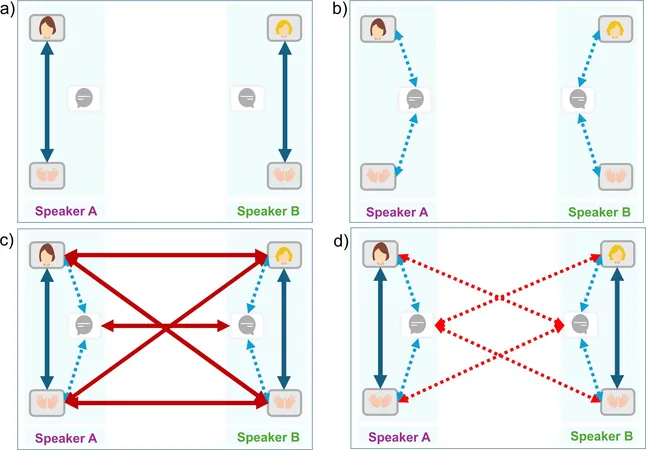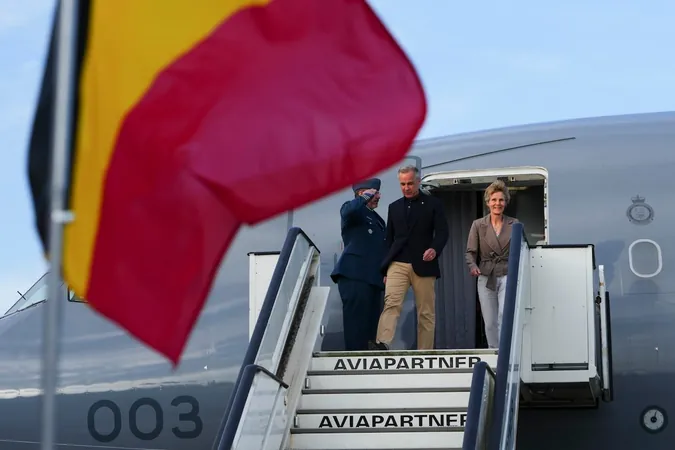
Unlocking the Secrets of Conversation: How Synchronization Shapes Our Social Interactions!
2024-09-25
Author: William
Introduction
In an intriguing new study released on September 25, 2024, in the journal PLOS ONE, researchers have shed light on the complex dynamics of turn-taking during conversations and how it significantly boosts the synchronization of verbal and nonverbal cues. The study, led by Tifenn Fauviaux and her team from the University of Montpellier, France, lays down a fundamental understanding of how effective communication really works.
Complex Dynamics of Conversation
Conversations are more than just a simple exchange of words—they are a complex interplay of vocal and physical expressions. While past research has demonstrated that speech and gestures tend to align within individuals, there has been minimal exploration into how this synchronization manifests between conversation partners.
Research Methodology
To dive deeper, Fauviaux and her colleagues employed an extensive online dataset that included 14 different sessions of unstructured face-to-face conversations. Each session, lasting between seven and 15 minutes, allowed pairs of participants to freely discuss chosen topics, ranging from light-hearted banter to serious debates.
Key Findings
The groundbreaking analysis of both audio and motion data focused specifically on two crucial areas: the speech amplitude envelope and the intricate movements of participants’ head and wrist gestures. By examining these elements at various timescales, the researchers found compelling evidence of synchronization not only within individuals but also between conversation partners.
Synchronization in Conversation
Their findings revealed a fascinating level of coordination: the movements of one person’s wrist and head not only synchronized with their own speech but also aligned perfectly with their partner’s vocalizations. This indicates that the rhythm of conversation goes beyond mere words, as gestures and speech work in harmony to enhance understanding and connection during verbal exchanges.
Implications and Future Research
This pioneering research has the potential to inform broader discussions around social behavior and may provide valuable insights into conditions characterized by social deficits, such as autism spectrum disorders. Fauviaux and her team suggest that further investigation can illuminate how these multimodal dynamics influence prosocial behaviors and communication strategies.
Conclusion
The authors pose a compelling question that resonates with everyone: "How do my speech and actions influence, or respond to, the speech and actions of the person I'm communicating with?" This study adeptly answers that by examining the dynamic relationship between speech and movement, illuminating the importance of synchronization at both the individual and interpersonal levels. In summary, the findings of this research not only enhance our understanding of social interactions but also emphasize the critical role that turn-taking plays in fostering connectedness. The implications of this study inspire us to rethink how we engage in conversations and how we can improve our communication skills. Stay tuned as future research unfolds—who knows what other secrets the art of conversation may hold?









 Brasil (PT)
Brasil (PT)
 Canada (EN)
Canada (EN)
 Chile (ES)
Chile (ES)
 Česko (CS)
Česko (CS)
 대한민국 (KO)
대한민국 (KO)
 España (ES)
España (ES)
 France (FR)
France (FR)
 Hong Kong (EN)
Hong Kong (EN)
 Italia (IT)
Italia (IT)
 日本 (JA)
日本 (JA)
 Magyarország (HU)
Magyarország (HU)
 Norge (NO)
Norge (NO)
 Polska (PL)
Polska (PL)
 Schweiz (DE)
Schweiz (DE)
 Singapore (EN)
Singapore (EN)
 Sverige (SV)
Sverige (SV)
 Suomi (FI)
Suomi (FI)
 Türkiye (TR)
Türkiye (TR)
 الإمارات العربية المتحدة (AR)
الإمارات العربية المتحدة (AR)